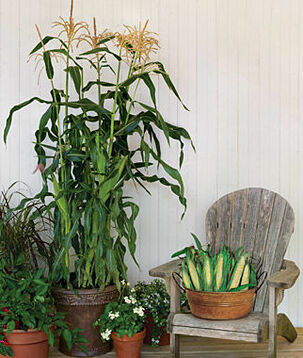How to Grow Corn in Containers
If you have limited gardening space you may have assumed that you didn't have enough room to grow sweet corn. You may be surprised to learn that you can grow corn in containers on the deck or along the foundation of your home. The corn shown above is a special hybrid corn developed for containers and was introduced by Burpee Seeds. While you do not need to grow this variety, there are some things you should look for if you want to try your hand at growing corn in a container.
Choose a corn variety with a height of 4 to 5 feet.
Taller corn requires more room for the roots to grow and may not do well in containers. Shorter varieties work well because they have smaller roots systems and because they are not as top heavy. Short corn varieties are less likely to topple the container during storms or from high winds.
Choose corn with short days to maturity.
Burpee's On Deck Hybrid Corn ripens in just 61 to 63 days. Shorter days to maturity means fewer days to care for the corn in your containers and will reward you with an early harvest.
Prepare soil for your containers.
Graden loam alone is not a good choice for containers as it tend to compact easily with repeated waterings. Make your own soil mix by combining equal parts potting soil, compost or well-rotted manure, and perlite. This makes a lightweight potting mix that promotes good drainage and provides your corn with slow-release nutrients.
Make drainage holes in the bottom of the container.
If you are using a bucket or a container that does not have drainage holes, you will need to drill holes around the outside of the container about 2 inches from the bottom to allow for water to drain through the pot when you water your container corn.
Plant 5 to 9 corn kernels per container.
Burpee recommends 9 kernels per 24 inch (diameter) pot. If you are using a smaller container or bucket you will need to plant fewer kernels.
Place you container in full sun.
Select a location for your corn where it will receive full sun for at least 6 to 8 hours a day. Full-day sun is even better.
Water your container corn frequently.
Water the container until the soil is saturated and water runs freely through the drainage holes at the bottom of the pot. Keep the soil moist (but not soggy) until your seedlings emerge in 7 to 10 days.
Water your container corn whenever the soil dries an inch or two below the surface. During hot, dry spells you may need to water your corn once or twice a day as soil in containers dries out quickly in the summer sun.
Water your container corn whenever the soil dries an inch or two below the surface. During hot, dry spells you may need to water your corn once or twice a day as soil in containers dries out quickly in the summer sun.
Fertilize with water-soluble fertilizer.
Apply water-soluble fertilizer (like Miracle-Gro) when you corn seedlings are about a foot tall. Repeat, following the application rate on the package, every 10 to 14 days. Plants grown in containers typically need more frequent ferltilizer than those grown in the soil because some of the nutrients leach through the bottom of the pot with frequent watering.
Harvest your corn when the silk is dark and the ears are plump.
Your container corn may ripen sooner or later than the projected days to maturity. Check that the fine strand of silk have turned brown and the kernels have filled out sufficiently before picking your corn.
